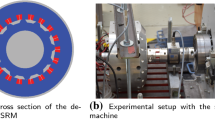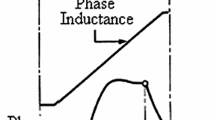Abstract
Cloud robotics has undergone rapid development. As an important candidate for direct-drive manipulator, switched reluctance machines (SRMs) face significant challenge in terms of control used in cloud robotics because of latency and package losses in network communication. In this paper, predictive current control of SRMs is extended to use in controller upon cloud in the face of latency and package losses. The starting point of predictive model is modified to eliminate errors caused by latency in sensor-controller communication, and the execution of control command sequence is dynamically regulated according to the arrival time of the following sequence to adapt for latency and package losses in controller-actuator communication. The proposed control method is evaluated in a 1.5 kW SRM test platform and comparison with a conventional control method is performed; the results show that the proposed control method has better tracking performance in face of time delay and package losses in transmission.












Similar content being viewed by others
References
Aghili, F., Buehler, M., Hollerbach, J.M.: Development of a high-performance direct-drivejoint. Adv.Robot. 16, 233–250 (2002). doi:10.1109/IROS.2000.895289
Chen, H., Zhang, D.: The switched reluctance motor drive for the direct-drive joint of the robot. In: Proceedings of the 18th IEEE International Conference on Robotics and Automation, May 2001. Vol. 2, pp. 1439–1443. doi:10.1109/ROBOT.2001.932812
Cao, J.Y., Chen, Y.P., Zhou, Z.D.: Robust control of switched reluctance motors for direct-driverobotic applications. Int. J. Adv. Manuf.Tech. 22(3–4), 184–190 (2003). doi:10.1007/s00170-002-1458-0
Cheung, N.C.: A compact and robust variable reluctance actuator for grasping applications. In: Proc. 24th Annu. Conf. IEEE, Volume. 2 (1998). doi:10.1109/IECON.1998.724244
Schulz, S.E., Rahman, K.M.: High-performance digital PI current regulator for EV switchedreluctance323 motor drives. IEEE Trans. Ind.Appl 39(4), 1118–1126 (2003). doi:10.1109/IAS.2002.1043751
Sahoo, S.K., Panda, S.K., Xu, J.X.: Indirect torque control of switched reluctance motors usingiterative learning control. IEEE Trans. Power.Electron 20(1), 200–208 (2005). doi:10.1109/TPEL.2004.839807(410)
Rafiq, M., Rehman, S., Rehman, F., Butt, Q.R., Awan, I.: A second order sliding mode control design of a switchedreluctance motor using super twisting algorithm. Simulation Modelling Practiceand Theory. Simul. Model. Pract.Theory 25(6), 106–117 (2012). doi:10.1016/j.sim.pat.2012.03.001
Loria, A., Espinosa-Perez, G., Chumacer, E.: Robust passivity-based control of switched reluctancemotors. Int. J. Robust. Nonlinear.Control 25(17), 3384–3403 (2014). doi:10.1002/rnc.3270
Bristow, D., Alleyne, A.: A high precision motion control system with application tomicroscale robotic deposition. IEEE Trans. ControlSyst.Tech 16, 1008–1020 (2006). doi:10.1109/TCST.2006.880189
Kehoe, B., Patil, S., Abbeel, P., Goldberg, K.: A survey of research on cloud robotics andautomation. IEEE Trans. Autom. Sci.Eng. 12(2), 398–409 (2015). doi:10.1109/TASE.2014.2376492
Wan, J., Tang, S., Yan, H., Li, D., Wang, S., Vasilakos, A.: Cloud robotics: current status and openissues. IEEEAccess 4, 2797–2807 (2016). doi:10.1109/ACCESS.2016.2574979
Addad, B., Amari, S., Lesage, J.: Client-server networked automation systems reactivity:deterministic and probabilistic analysis. IEEETrans. Autom. Sci.Eng. 8(3), 540–548 (2011). doi:10.1109/TASE.2011.2116118
Lian, F.: Analysis, design,modelling and control of networked control systems. PhD Dissertation,Department of Mechanical Engineering, University of Michigan, Ann Arbor, MI,USA, (2001)
Branicky, M.S., Phillips, S.M., Zhang, W.: Stability of networked control systems: explicit analysis of delay. In: Proc. Amer. Control Conf., Chicago, IL, pp. 2352–2357 (2000). doi:10.1109/ACC.2000.878601
Georges, J.P., Rondeau, E., Divoux, T.: Confronting the performances of switched Ethernet network withindustrial constraints by using networkcalculus. Commun.Syst. 18(9), 877–903 (2005). doi:10.1109/ITC.2013.6662955
Lee, K.C., Lee, S.: Performance evaluation of switched Ethernet for real-timeindustrial communications. Comput. Stand.Interfaces 24(5), 411–423 (2002). doi:10.1016/S0920-5489(02)00070-3
Addad, B., Amari, S., Lesage, J.-J.: Analytic calculus of response time in networked automationsystems. IEEE Trans. Autom. Sci.Eng. 7(4), 858–869 (2010). doi:10.1109/TASE.2010.2047499
Witsch, H.D., Vogel-Heuser, B., Faure, J.-M., Poulard-Marsal, G.: Performance analysis of industrial Ethernet networks by means of timed model-checking. In: Proc. 12th IFAC INCOM, St-Etienne, France, pp. 101–106 (2006). doi:10.1016/B978-008044654-7/50151-5
Greifeneder, J., Frey, G.: Optimizing quality of control in networked automation systems using probabilistic models. In: Proc. 11th IEEE Int. Conf. ETFA, Prague, Czech Republic, pp. 372–379 (2006). doi:10.1109/ETFA.2006.355428
Denis, B., Ruel, S., Faure, J.M., Marsal, G.: Measuring the impact of vertical integration on response times in Ethernet fieldbuses. In: Proc. 12th IEEE Int. Conf. Emerging Technol. Factory Autom., Patras, Greece, pp. 332–339 (2007). doi:10.1109/EFTA.2007.4416815
Vallabhan, M., Seshadhri, S., Ashok, S.,Ramaswmay, S., Ayyagari, R.: An analytical framework for analysis and design ofnetworked control systems with random delays and packet losses. In: Proc. 25thCCECE. Conf., Quebec, Canada (2012)
Liu, F.C., Yao, Y.: Modeling and analysis of networked control systems using hidden markov models. In: Proc. 4th Int. Conf. Machine Learning and Cybernetics, pp. 18–21 (2005). doi:10.1109/ICMLC.2005.1527076
Lee, S., Lee, S.H., Lee, K.C.: Remotefuzzy logic control for networked control system. In: 27th IECON, pp. 1822–1827(2001). doi:10.1109/IECON.2001.975567
Huo, Z., Fang, H.: Robust\(H_\infty \) filter design for networked control system with random time delays.In: Proc. 10th IEEE Int. Conf. Eng. Complex Computer Systems, pp. 333–0,(2005). doi:10.1109/ICMLC.2007.4370205
Sinopoli, B., Schenato, L., Franceschetti, M., Polla, K., Jordan, M.I., Sastry, S.S.: Kalman filtering with intermittentobservations. IEEE Trans. Autom.Control 49(9), 1453–1464 (2004). doi:10.1109/TAC.2004.834121
Liu, G.P., Chai, S.C., Mu, J.X., Rees, D.: Networked predictive control of systems with random delay insignal transmission channels. Int. J. Syst.Sci. 39(11), 1055–1064 (2008). doi:10.3182/20050703-6-CZ-1902.00909
Tang, P., C. Silva, C.: Compensation for transmission delays in an Ethernet-based control network using variable-horizon predictive control. In: IEEE Trans. Contr., Syst. Technol., vol. 14, pp. 707–718 (2006). doi:10.1109/TCST.2006.876640
Kouro, S., Cortés, P., Vargas, R., Ammann, U., Rodríguez, J.: Model predictive control—a simple and powerful method to controlpower converters. IEEE Trans. Ind.Electron. 56(6), 1826–1838 (2009). doi:10.1109/TIE.2008.2008349
Geyer, T., Papafotiou, G., Morari, M.: Model predictive direct torque control—Part I: concept,algorithm, and analysis. IEEE Trans. Ind.Electron. 56(6), 1894–1905 (2009). doi:10.1109/TIE.2008.2007030
Geyer, T.: Model predictive direct current control: formulation of thestator current bounds and the concept of the switchinghorizon. IEEE Ind. Appl.Mag. 18(2), 47–59 (2012). doi:10.1109/MIAS.2011.2175518
Mikail, R., Husain, I., Sozer, Y., Islam, M.S., Sebastian, T.: Torque ripple minimization of switched reluctance machinesthrough current profiling. IEEE Trans. Ind.Appl. 49(3), 1258–1267 (2013). doi:10.1109/TIA.2013.2252592
Kioskeridis, I., Mademlis, C.: Maximum efficiency in single pulse controlled switched reluctancemotor drives. IEEE Trans. Energy.Convers. 20, 809–817 (2005). doi:10.1109/TEC.2005.853738
Ye, J., Bilgin, B., Emadi, A.: An offline torque sharing function for torque ripple reduction inswitched reluctance motor drives. IEEE Trans.Energy.Convers. 30(2), 726–735 (2015). doi:10.1109/TEC.2014.2383991
Li, X., Shamsi, P.: Model predictive current control of switched reluctance motorswith inductance auto-calibration. IEEE Trans. Ind.Electron. 63(6), 3934–3941 (2016). doi:10.1109/TIE.2015.2497301
Zhou, Q., Luo, J.: The study on evaluation method of urban network security in the big data era. Intell. Autom. Soft Comput. (2017). doi:10.1080/10798587.2016.1267444
Xue, X.D., Cheng, K.W.E., Ho, S.L.: Optimization and evaluation of torque-sharing functions fortorque ripple minimization in switched reluctance motordrives. IEEE Trans. PowerElectron. 24(9), 2076–2090 (2009). doi:10.1109/TPEL.2009.2019581
Acknowledgements
This work was supported by the National Natural Science Foundation of China (No. 51305258).
Author information
Authors and Affiliations
Corresponding author
Rights and permissions
About this article
Cite this article
Li, B., Ling, X., Huang, Y. et al. Predictive current control of a switched reluctance machine in the direct-drive manipulator of cloud robotics. Cluster Comput 20, 3037–3049 (2017). https://doi.org/10.1007/s10586-017-0983-4
Received:
Revised:
Accepted:
Published:
Issue Date:
DOI: https://doi.org/10.1007/s10586-017-0983-4




